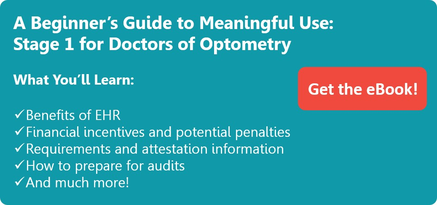4 Guidelines to Follow When Selecting EHR Software
So you’ve heard it all when it comes to Electronic Health Records (EHRs). 2011 Certified. Integrated. 2014 Certified. Modular. The list goes on and on! But how could one possibly know which is best? With over 500 EMR and EHR software suppliers, it can be difficult to pin down which system is right for your eye care practice. Worry no more! With these 4 things to look out for, you’re sure to find the perfect EHR Software for your eyecare practice.

1. Choose an EHR Software Vendor That is in it to Win it
Folks, we aren’t talking about football or any other sport for that matter. We are talking about finding an exceptional vendor. Ask yourself these questions. Have you worked with this vendor before? What does their track record look like? How about their reputation? Some great ways to sort out which vendors are “in it to win it” are reading reviews, talking to other ODs, reading industry publications, and requesting demos from multiple vendors. Finding a vendor that will be around for the long haul and more importantly, one you can trust, is a must. Regardless of how careful you are or how fantastic the EHR is, there is bound to be a hiccup along the way. And, waiting until you actually need help to find out if the vendor is reliable is never a smart move.
Think of it this way. No matter how talented an athlete may be, if the coach is running terrible plays and offers no support, sooner or later that athlete is going to fail. Similarly, no matter how awesome an EHR is, if the vendor is not devoted to supporting you, staying ahead of the technological curve, and upgrading the software, it too, like the athlete, will fail.
 2. Verify it’s Certified
2. Verify it’s Certified
Certified vs. Uncertified
This one is easy. Of course you want your EHR software to be certified! Why, you ask? Because the EHR Incentive Program pays you for practice management meaningful use at your eyecare practice! You could actually earn up to $44,000 from the Medicare Incentive Program! But, in order to be certified, the EHR must have the latest upgrades from the vendor. In short, systems that are certified for 2011 are compiant with Stage 1 of the incentive program. Those that are certified for 2014 will be certified to show Meaningful Use in both Stage 1 and Stage 2.
So, if your practice is looking into acquiring a traditional client-server EHR, these upgrades can be expensive –in both installation-time AND money! Rather than paying cold hard cash to upgrade the system yourself, a cloud-based EHR is automatically upgraded by the vendor (for free)! Thus, you never need to worry about your cloud-based EHR being uncertified because it is always running the most updated version.
Keep note that EHR systems only need to be certified before EHR incentive payments are received, not at the time of installation.
Complete vs. Modular
So, you know you want your EHR to be certified, but to what extent? There are two types of certification: complete or modular. Complete certification simply means that the system has met all criteria for the Final Rule of meaningful use. On the other hand, modular systems have only met some criteria for meaningful use. Thus, it may take multiple modular systems to fulfill the Clinical Quality Measures, Core, and Menu Objectives of the EHR Incentive program.
 3. System Structure
3. System Structure
Any reputable architect knows that the structure determines the outcome of the rest of the building. If the structure is affordable and solid, the architect can customize and change the building to satisfy his needs. But, if the structure is expensive and complicated, the architect has a lot harder time doing so. Likewise, the structure of an EHR matters.
On one end of the spectrum, we have an EHR that utilizes an on-premise server to store all medical records. This is comparable to the structure that is expensive and complicated. The eye care practice is responsible for purchasing expensive hardware, all security, and upkeep. In fact, just getting the system up and running requires a complicated and long set-up. And in order to remain functional, this system must be maintained with upgrades and tech support (all of which come out of the practice’s pocket). Also, all data backup must be completed manually, and storage is limited to what the practice owns. Other than actually owning the software/license, there are not many benefits to this setup.
On the other end of the spectrum, we have an EHR that is cloud-based and offered as software as a service (SaaS). Think of this EHR as an affordable yet solid structure. There are no heavy upfront costs associated with this because all that is needed to access this EHR is a device with an internet connection. Thus, there are little to no hardware costs. All security measures, maintenance, and upgrades are performed by the vendor. Most cloud vendors adhere to stringent government regulations, like HIPAA compliance, so you know your data is secure. In fact, most cloud-hosting facilities provide an even safer environment than you alone could offer at your practice.
 4. Integrated with a Practice Management System
4. Integrated with a Practice Management System
Yes, it is possible to purchase an EHR and attempt to integrate it with your practice management system, but why waste precious time and money doing so? Did you know that it could cost you thousands of dollars just to reach a semi-integrated level? And, you may not even obtain the benefits of full practice management integration:
- Less screens to click through
- Data and work flow are intuitive
- Improves quality of care offered to patients
- Both PMS and EHR work in tandem, increasing functionality
- Increases efficiency overall
Bonus: if the EHR also integrates with your equipment, then examinations should be seamless, creating even greater efficiency!
With these 4 tips in hand, you are ready to go out and find the perfect EHR for your practice! Just remember that the finest EHRs have Complete Certification (preferably through Stage 2 if you want to continue benefiting from the EHR Incentive Program), are offered as software as a service (SaaS) through the cloud, are integrated with a practice management system, and have a reputable vendor that sticks behind it.
Learn more about the EHR Incentive Program and Meaningful Use!

